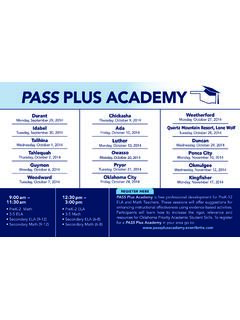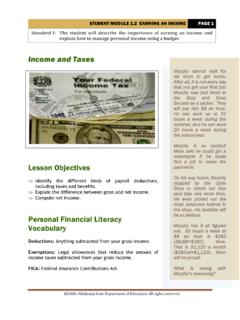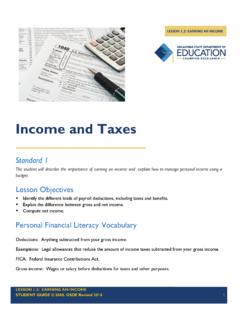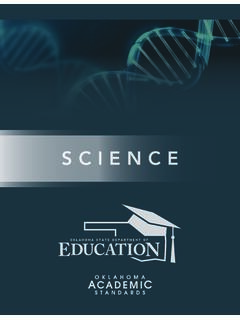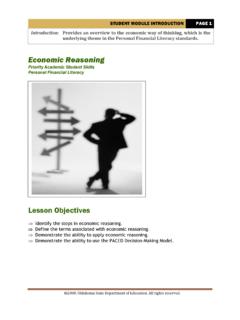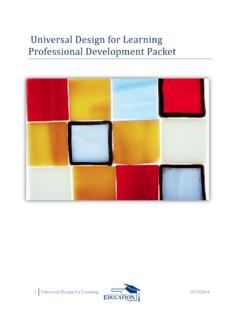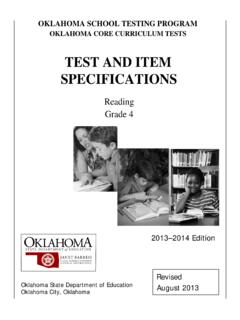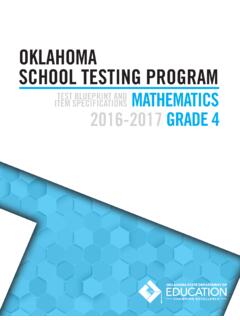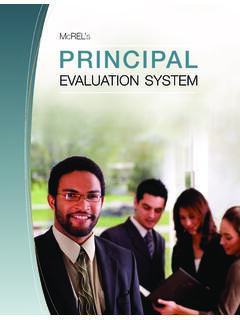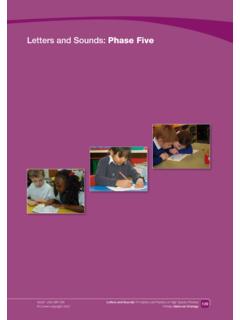Transcription of Oklahoma Academic Standards ENGLISH LANGUAGE ARTS
1 EducationOklahoma Academic StandardsENGLISH LANGUAGE ARTS Table of Contents 2 Oklahoma Academic Standards for ENGLISH LANGUAGE Arts Introduction Guiding Principles 3 Grade 5 62 Eight Overarching Standards 6 Grade 6 72 Navigating the Standards 9 Grade 7 80 Pre-Kindergarten 10 Grade 8 88 Kindergarten 16 Grade 9 96 Grade 1 24 Grade 10 104 Grade 2 34 Grade 11 112 Grade 3 44 Grade 12 120 Grade 4 53 Guiding Principles Teachers use Standards as guides for developing curriculum and instruction that is engaging, challenging, and sequenced for the students in their care.
2 By nature, acquiring LANGUAGE arts knowledge and skills is a recursive learning endeavor: students revisit concepts again and again as they use LANGUAGE at increasingly sophisticated levels. Because of this recursive learning process, LANGUAGE arts learning will not progress for students in the strictly linear way it may in other content areas. Nonetheless, it is important for any set of Standards to provide concise, written descriptions of what students are expected to know and be able to do at a specific stage of their education (Great Schools Partnership, 2014).
3 In order to make this document a clear, coherent description of what students are expected to know and be able to do at specific stages, the writers have adopted some guiding principles for design and organization: clarity, coherence, and purpose. Clarity Standard statements are written with verbs that indicate specifically what learning students must demonstrate and at what depth. When students compare, paraphrase, predict, or summarize, they are able to show a broader range of mastery of a concept than when they are expected to identify or recognize.
4 However, the writers also have given full consideration to the complexity of the content itself. For example, it is more challenging to identify the implied theme of an extended essay than to identify the subject of a sentence. The progression of ENGLISH LANGUAGE arts learning from pre-kindergarten through high school should reflect the relationship between the level of critical thinking students use and the actual listening, speaking, reading, and writing experiences students have. Content to be emphasized and assessed at specific grade levels is clearly identified.
5 Some objectives are formatted with bullets for easier reading; bulleted skills can be learned in any particular order. In order to align with research on the science of reading, some objectives in Standard 2 Reading and Writing Foundations use lowercase letters for their bullets to indicate a researched-based sequence of learned skills. When lowercase letters are used instead of bullets, this shows a general sequence for how these skills would build upon one another. In this sequence, students practice a skills before practicing b skills and so on.
6 While research supports this general sequence, some curriculum resources may use a slightly different sequence, and the fidelity of the curriculum resource should be honored. When a parenthetical phrase or statement is used to provide further clarity to an objective, and are sometimes used. = those are the only things to consider (Latin for that is ) = those are just some possible examples (Latin for for example ) Additional guidance and support documents will be provided on the ELA website ( ) and the Oklahoma Curriculum Framework for ENGLISH LANGUAGE Arts ( ).
7 3 Oklahoma Academic Standards for ENGLISH LANGUAGE Arts Introduction Coherence The Oklahoma Academic Standards for ENGLISH LANGUAGE Arts identify the knowledge and skills that Pre-K 12 students should know and be able to do by the end of a grade level; each standard for every grade is delineated at the appropriate level. The Standards are presented by individual grade level with the reading and writing strands in a side-by-side format, encouraging an integrated approach to ENGLISH LANGUAGE arts. When a skill is no longer present, mastery is implied; however, teachers must support previous grade-level skills according to the mastery level of their students.
8 For some grade levels in the Standard 5 LANGUAGE writing strand, the grade of mastery is indicated for some mechanics skills. The encoding objectives in the Spelling/Encoding section of Standard 2 Reading and Writing Foundations will often mirror the decoding Standards from the previous grade in the phonics and Word Study section of the same standard. Users must examine all of the Standards for each grade level as a whole to have a coherent understanding of what is required of learners. Because of the interconnectedness of LANGUAGE arts concepts and skills, various aspects of what students know and can do may be described in more than one standard.
9 For example, learners conducting research (Standard 6) should use listening and speaking (Standard 1), reading and writing processes (Standard 2), Academic vocabulary (Standard 4), critical reading and writing (Standard 3), formal grammar and usage (Standard 5), and more than likely, they will access research and complete their research products because they are competent in multimodal literacies (Standard 7). As students progress through grade levels, expectations encompass the content of the previous grades.
10 Specifically, in connection to reading assignments, the complexity of texts increases as students advance to later grades; however, simpler texts can be used effectively in order for learners to develop a deeper understanding of content such as theme, figurative LANGUAGE , genre, and structure. 4 Oklahoma Academic Standards for ENGLISH LANGUAGE Arts Introduction Purpose In addition to a commitment to clear and coherent Standards , the writers were guided by four fundamental purposes of ENGLISH LANGUAGE arts education.
